
OSU Scientists Double Carbon Capture Efficiency in MOFs
**Oregon State University scientists have made significant strides in carbon capture technology by enhancing the efficiency of metal-organic frameworks (MOFs) used for scrubbing carbon dioxide from industrial emissions.** MOFs are crystalline materials with high porosity, making them effective at trapping gases. The research team, led by Kyriakos Stylianou, discovered that exposing a copper-based MOF (mCBMOF-1) to ammonia gas more than doubled its carbon absorption capacity. _This advancement makes its performance comparable to or even better than traditional amine-based sorbents, which are commonly used in industry._ The process involves activating the MOF by removing water molecules, which exposes open copper sites. Ammonia gas is then introduced, occupying one site and attracting CO2 to the remaining sites. This interaction forms carbamates, which are released during water immersion. _This not only regenerates the MOF for reuse but also uses less energy compared to amine-based sorbents._ The study highlights the potential of customizing MOF structures with functional groups to target specific molecules like CO2. These findings open avenues for applying similar strategies to other MOFs and gases, enhancing CO2 capture without significantly increasing energy costs. The research, supported by Saudi Aramco, was published in JACS Au and involved collaboration with multiple international scientists.